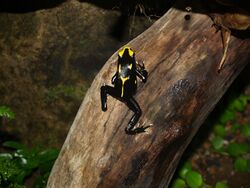Biology:Dyeing dart frog
| Dyeing dart frog | |
|---|---|

| |
| Scientific classification | |
| Domain: | Eukaryota |
| Kingdom: | Animalia |
| Phylum: | Chordata |
| Class: | Amphibia |
| Order: | Anura |
| Family: | Dendrobatidae |
| Genus: | Dendrobates |
| Species: | D. tinctorius
|
| Binomial name | |
| Dendrobates tinctorius (Cuvier, 1797)
| |
The dyeing dart frog, dyeing poison dart frog tinc (a nickname given by those in the hobby of keeping dart frogs), or dyeing poison frog (Dendrobates tinctorius) is a species of poison dart frog. It is among the largest species, reaching lengths of 50 mm (2.0 in). This species is distributed throughout the eastern portion of the Guiana Shield and Venezuela, including parts of Guyana, Suriname, Brazil , and nearly all of French Guiana.
Poison
Like most species of the genus Dendrobates, D. tinctorius is highly toxic if consumed. It produces pumiliotoxins that the frog uses for self-defense. While pumiliotoxins are weaker than their derivative allopumiliotoxins and the batrachotoxins secreted by Phyllobates species, they are sufficiently toxic to discourage most animals from feeding on them. In the case of D. tinctorius, the toxins cause pain, cramping, and stiffness when the frogs are handled roughly. Due to the toxins of the frogs, animals that feed on D. tinctorius will typically learn to associate the bright colours of such frogs with the vile taste and pain that occurs after a frog is ingested. As it is such a variable species, different color morphs of D. tinctorius have varying degrees of toxicity.
Local tribes use D. tinctorius for decoration. Feathers are plucked from the back of young parrots and the frogs are rubbed on the parrots' exposed skin. When the feathers regrow, the toxin causes them to appear yellow or red rather than green. These altered feathers are highly prized by the indigenous tribes.
Description
The dyeing poison dart frog is large for a poison dart frog, but may be smaller than Phyllobates terribilis and Ameerega trivittata. Many small forms of D. tinctorius reach 3.5 cm long; most morphs are around 5 cm in length or slightly bigger; some of the larger morphs may exceed 7 cm, although large ones are usually closer to 5.5 cm long. For some time, captive individuals were thought to be incapable of reaching the sizes of wild specimens; however, later evidence suggested captive individuals do not reach their maximum potential size possibly due to vitamin and mineral deficiencies. More recently, breeders had success raising dyeing poison dart frogs to very large sizes.
Dendrobates tinctorius is one of the most variable of all poison dart frogs. Typically, the body is primarily black, with an irregular pattern of yellow or white stripes running along the back, flanks, chest, head, and belly. In some morphs, however, the body may be primarily blue (as in the "azureus" morph, formerly treated as a separate species), primarily yellow, or primarily white. The legs range from pale blue, sky blue or blue-gray to royal blue, cobalt blue, navy blue, or royal purple and are typically peppered with small black dots. The "Matecho" morph is almost entirely yellow and with some black, with only a few specks of white on the toes. Another unique morph, the citronella morph, is primarily golden yellow with tiny splotches of black on its belly and royal blue legs that have no black dots.
Males are typically smaller and more slender than females, but they have larger toe discs. The toe discs of female dyeing poison dart frogs are circular while those of the males are heart-shaped. Also the females have arched backs as opposed to males who have curved ones.
Distribution
It exists in discrete patches throughout this region, being restricted to "highland" (up to 350 m (1,150 ft)) areas. While this species can be found at sea level, individuals have been collected at the base of nearby hills or mountains. The isolation of populations has presumably occurred as a result of the erosion of these highland areas and the seasonal inundation of the inter-patch areas.
Morphs
The species encompasses a great diversity of color and patterning variants (subspecies and morphs). Some batrachologists suspect that some of these are actually different species.
Etymology
The specific name tinctorius comes, however, not from the variety of colors, but from the legends of some indigenous tribes. It has been said that tribe members used the frog poisons to cause green parrot feathers to grow different colors. [1]
References
- Gaucher; MacCulloch (2004). "Dendrobates tinctorius". IUCN Red List of Threatened Species 2004. https://www.iucnredlist.org/details/55204/0. Retrieved 12 May 2006. Database entry includes a range map and a brief justification of why this species is of least concern
Further reading
Born, Marga; Bongers, Franz; Poelman, Erik; Sterck, Frank (June 2010). "Dry-season retreat and dietary shift of the dart-poison frog Dendrobates tinctorius (Anura: Dendrobatidae)". Phyllomedusa 9 (1): 37–52. http://www.revistas.usp.br/phyllo/article/view/42724. Retrieved 20 April 2015.
Ringler, Eva; Rojas, Bibiana; Ringler, Max; Hödl, Walter (October 2012). "Characterization of nine polymorphic micro satellite loci in the dyeing poison frog Dendrobates tinctorius (Dendrobatidae), and their cross-species utility in two other dendrobatoid species". Herpetological Journal 22 (4): 263–265. ISSN 0268-0130.
Rojas, Bibiana; Endler, John A. (22 Jun 2013). "Sexual dimorphism and intra-populational colour pattern variation in the aposematic frog Dendrobates tinctorius". Evolutionary Ecology 27 (4): 739–753. doi:10.1007/s10682-013-9640-4.
External links
Wikidata ☰ Q1478869 entry









